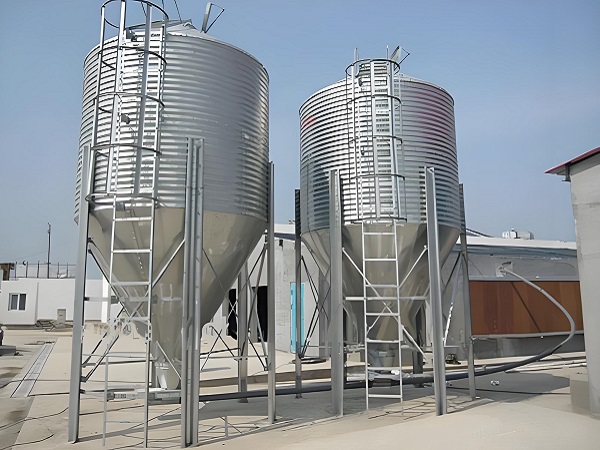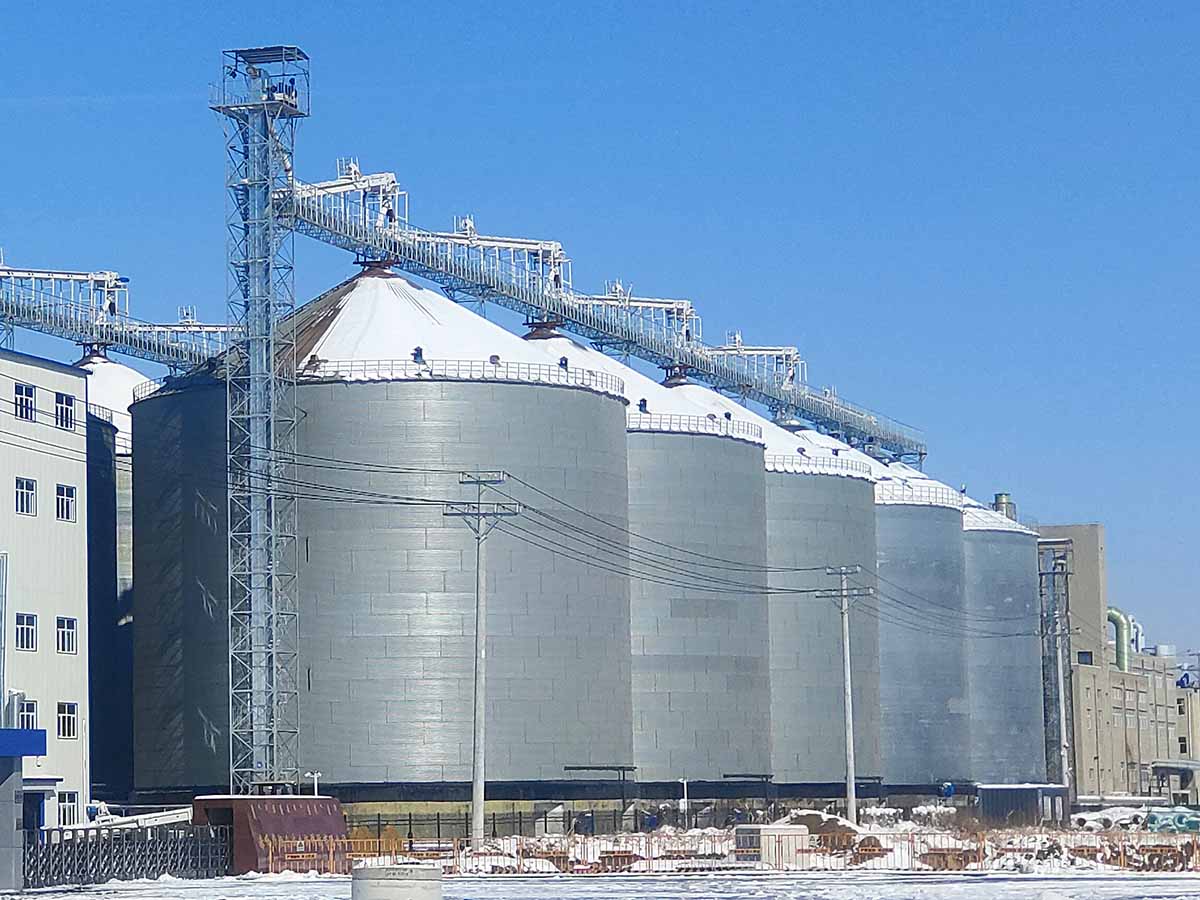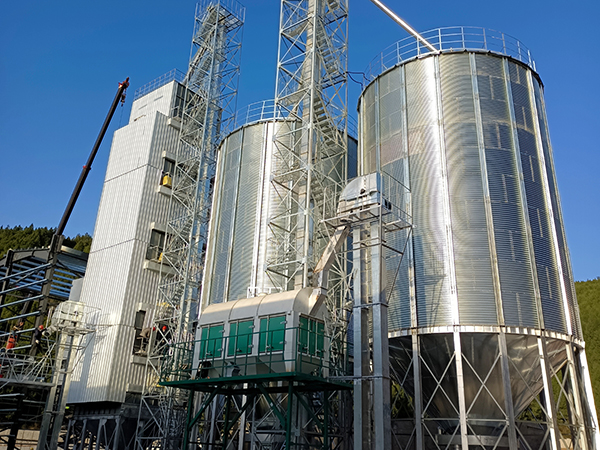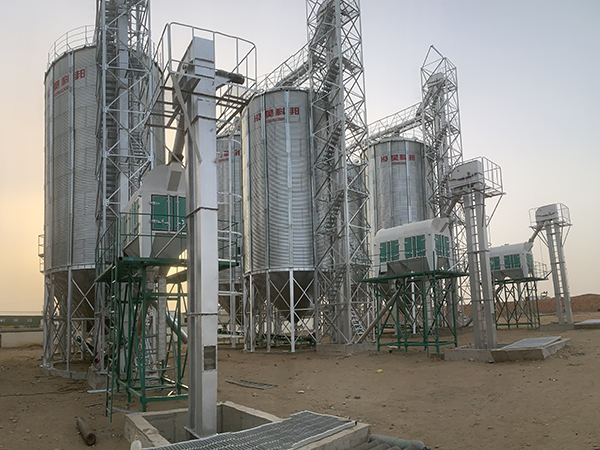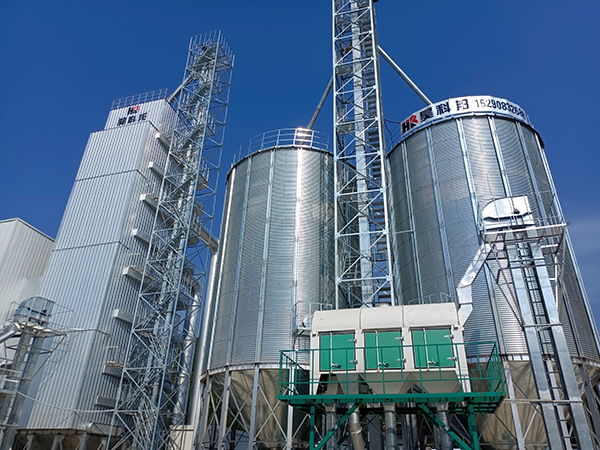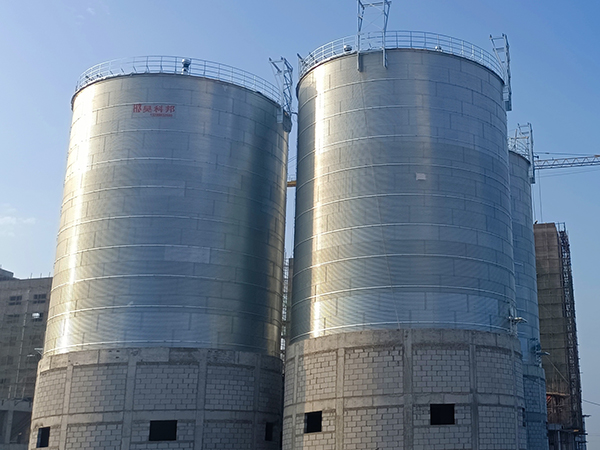100-ton silo
A 100-ton silo is a storage facility specifically designed to hold 100 tons of weight in grains or other agricultural products.
100-ton silo Introduction
A 100-ton silo is a storage facility specifically designed to hold 100 tons of weight in grains or other agricultural products. These silos are typically constructed from galvanized steel plates or concrete to ensure they can withstand the weight of the stored items as well as the impact of the external environment.
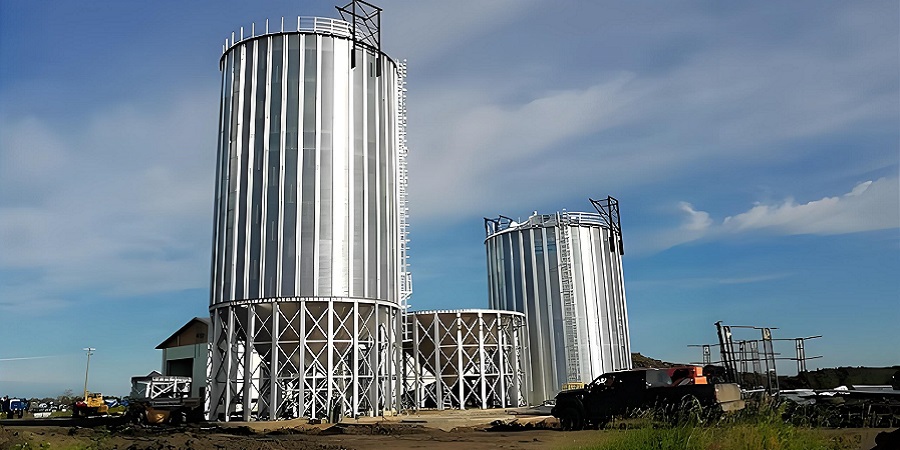
100 ton silo features
Capacity
The design capacity of this silo is 100 tons, making it suitable for medium-scale agricultural production and commercial operations.
Structure
The silo typically has a cylindrical structure, with the top and bottom possibly designed in conical or flat-bottom shapes to facilitate the loading and unloading of grain.
Materials
To ensure durability and resistance to corrosion, a 100-ton silo is usually constructed from high-quality steel or concrete.
Protectiveness
The design of the silo takes into account the protection of stored items from external factors such as humidity, temperature fluctuations, pests, and microorganisms.
Convenience in Operation
Modern 100-ton silos may be equipped with automated loading and unloading systems, making the operations of grain storage and retrieval more convenient and efficient.
Monitoring System
To ensure the safety and quality of stored items, the silo may be fitted with temperature and humidity monitoring systems, as well as other necessary sensors.
Ventilation System
A good ventilation system helps maintain an appropriate environment within the silo, preventing grain spoilage or mold growth.
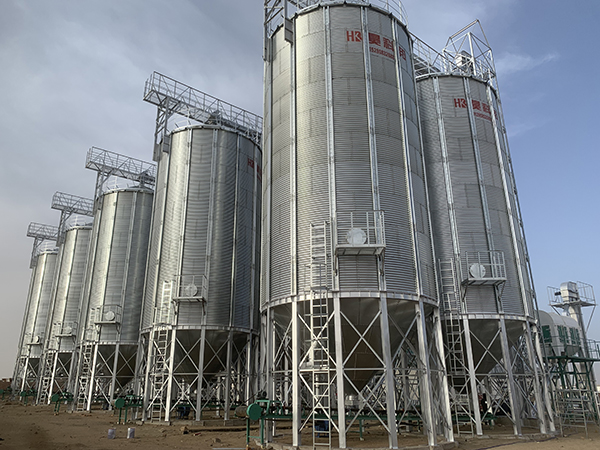
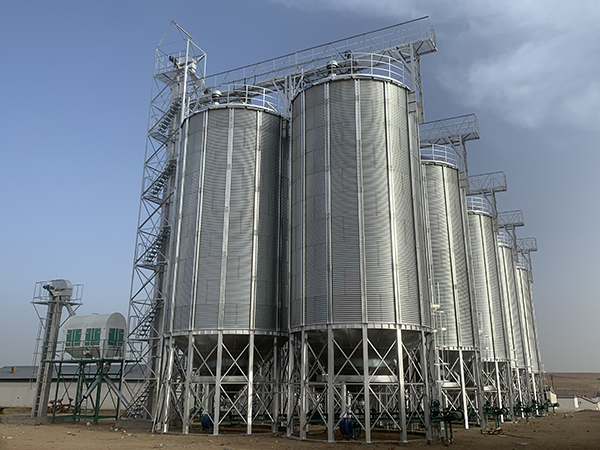
100 ton silo structure
Foundation
The foundation of the silo serves as the supporting element for the entire structure, ensuring the stability of the silo on the ground. The foundation is typically constructed using reinforced concrete pile foundations or other suitable ground treatment methods to bear the weight of the silo and its contents and distribute the load to the soil layer.
Lower Support Structure
For steel silos, this may include steel columns, ring beams, and legs, forming the support framework at the bottom of the silo, connecting the foundation to the silo body.
For concrete silos, the lower support structure may include concrete walls or columns, creating a closed or open space at the bottom of the silo to provide support for the silo body.
Silo Body
The silo body is the main part of the silo, usually made by welding steel plates or assembling precast concrete components to form a cylindrical storage space. The thickness of the silo body is determined based on design loads and material characteristics to ensure structural strength and durability.
Silo Roof
The silo roof includes the roof plate (also known as the roof cover or roof head) and the feeding system. The roof plate is typically designed as a flat or conical roof, made of welded steel plates or poured concrete, serving to seal the top of the silo and prevent rainwater infiltration. The feeding system includes the feeding port, dust cover, and conveyor equipment interface, used to receive and import materials.
Silo Conical Hopper or Outlet
The silo conical hopper, located at the bottom of the silo body, has a conical or flat-bottom structure that facilitates the concentration and smooth flow of materials. The hopper may be equipped with pneumatic or electric discharge equipment, such as discharge valves and vibrators, to control the discharge rate and flow of materials.
Top Feeding System
This includes the feeding port, dust cover, and conveyor equipment interface, used to receive and import materials. Materials are usually transported to the feeding port at the top of the silo via conveyor equipment (such as belt conveyors, elevators, etc.), and then enter the silo body through a feeding pipe or chute.
Dust Collector (Equipped as Needed)
Especially when storing materials that easily generate dust, the silo may be equipped with a dust collector to collect and handle dust generated during feeding and discharging processes, reducing environmental pollution and ensuring the health of operators and safe production.
Auxiliary Facilities
These include ladders, guardrails, maintenance doors, temperature and humidity sensors, ventilation systems, fire-fighting facilities, etc., providing necessary support for the daily maintenance, safety monitoring, and environmental control of the silo.
Enclosing Structures (Equipped as Needed)
These include insulation layers, waterproof layers, anti-corrosion coatings on the outside of the silo walls, as well as sun and rain protection facilities on the roof, ensuring that the internal environment of the silo meets the storage requirements of the materials and extends the service life of the silo.
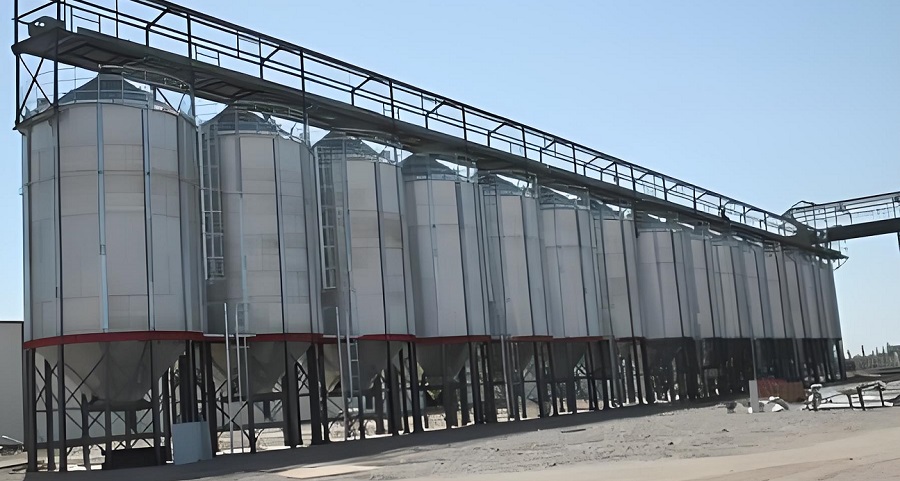
100 ton silo advantages
High Space Utilization
The cylindrical design of the silo allows for a large storage capacity within a unit area. Compared to traditional flat-bottom warehouses, it achieves more efficient use of storage space on limited land resources, especially suitable for occasions with tight land constraints or the need for large-scale centralized storage.
Good Sealing Performance
The silo has a compact structure and excellent sealing properties, effectively preventing the intrusion of external moisture, dust, pests, etc., protecting materials from pollution or spoilage. It is particularly suitable for materials with high storage environment requirements, such as grain, feed, and chemical raw materials.
Automated Material Handling System
The silo is usually equipped with advanced automated material handling equipment, such as belt conveyors, screw conveyors, pneumatic or electric discharge valves, etc., to achieve fast and accurate material transfer, greatly reducing manual labor intensity and improving work efficiency and accuracy.
Good Ventilation and Temperature and Humidity Control
The silo can be configured with a ventilation system to adjust the temperature and humidity inside the warehouse through natural or forced ventilation, preventing materials from clumping or molding due to high humidity, or heat damage due to high temperatures. For materials that require low-temperature storage, a cooling system can also be used for temperature management.
High Structural Strength and Good Safety
The silo is built with high-strength steel or concrete, featuring excellent compression resistance, wind resistance, and seismic performance, capable of withstanding adverse weather and natural disasters, ensuring the safety of material storage.
Easy Management and Monitoring
The silo can integrate IoT technology and be equipped with real-time monitoring devices, such as temperature and humidity sensors, level meters, etc., facilitating remote monitoring of the conditions inside the warehouse, timely warning of abnormal situations, and achieving refined inventory management and maintenance.
Environmental Protection and Energy Saving
By sealed storage and Supporting dust removal equipment, the silo can effectively reduce dust emissions during material loading and unloading, meeting environmental protection requirements. At the same time, good thermal insulation design can reduce energy consumption and lower energy costs in the storage and transportation process.
Flexibility and Scalability
The silo can be flexibly arranged and designed according to site conditions and storage needs, and can be used independently or arranged in groups to form a large storage area. When storage needs increase, the storage capacity can be quickly expanded by adding more silos.
Low Maintenance Cost and Long Service Life
Steel silos are treated with anti-corrosion, and concrete silos have natural durability, both of which have low maintenance costs and long service lives. Regular inspections and proper maintenance can ensure the long-term stable operation of the silo.
Application scope of 100 ton silo
Coban Silo is widely used for grain storage such as wheat, corn, soybean, paddy, rice, soybean meal, barley, malt, sunflower seeds, rapeseed, peanuts, flour, and other powder materials, oat, special Silo, and seeds, etc.

100 ton silo technical parameters
Scientifically speaking, the Silo capacity should be measured with volume (m3). Even in the same grain Silo, the storage tons will be different for different grains with different densities. The following table is calculated based on a Silo density of 0.75kg/m3, and surely HKB customizes Silo systems unique for you.
| Most Popular Hopper Bottom Steel Silo Technical Specifications | ||||||||
| Capacity | 50Ton | 100Ton | 150Ton | 200Ton | 300Ton | 500Ton | 1000Ton | 1500Ton |
| Model | TCZK
03605 |
TCZK
04507 |
TCZK
05507 |
TCZK
06406 |
TCZK
07307 |
TCZK
07313 |
TCZK
11010 |
TCZK
12811 |
| Diameter(m) | 3.667 | 4.584 | 5.500 | 6.417 | 7.334 | 7.334 | 11.000 | 12.834 |
| Total Height(m) | 9.56 | 12.53 | 13.25 | 12.85 | 14.70 | 21.42 | 20.95 | 23.51 |
| Volume(m³)
Density:0.75ton/m³ |
69 | 150 | 222 | 273 | 415 | 699 | 1346 | 2039 |
| Most Popular Flat Bottom Steel Silo Technical Specifications | ||||||||
| Capacity | 1000Ton | 1500Ton | 2000Ton | 2500Ton | 3000Ton | 5000Ton | 8000Ton | 10000Ton |
| Model | TCK
10014 |
TCK
11915 |
TCK
13715 |
TCK
15514 |
TCK
15518 |
TCK
18321 |
TCK
24718 |
TCK
25621 |
| Diameter(m) | 10.084 | 11.918 | 13.750 | 15.584 | 15.584 | 18.334 | 24.751 | 25.668 |
| Total Height(m) | 18.69 | 20.34 | 20.87 | 20.30 | 24.78 | 28.60 | 26.99 | 30.60 |
| Volume(m³)
Density: 0.75ton/m³ |
1335 | 2009 | 2701 | 2467 | 4145 | 6693 | 10879 | 13484 |
After-sale Service
- – HKB provides advanced grain safety storage technology to assure your grain silo 100% quality stability.
- – grain silo Quality guarantee is one year after installation and commissioning or 18 months after leaving China Port. Maturity is the first.
- – 7 days x 24 hours service, within 24 hours reply/solve of any technical issues upon request.
- – Routinely telephone track to remove all might be problems grain silo or issues guarantying the whole system grain silo long-lasting safety and reliability.
- – HKB will consider all other needs like customs clearance, sea delivery, insurance, customs tax benefit plan, documentation, etc. So our respected Users feel so relaxed and easy to get the grain silo system well.

